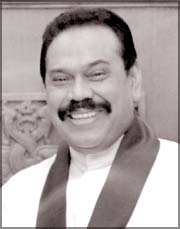A tale of two lions
Beant Singh and Mahinda Rajapaksa:
While one lion laid down his life but helped
wipe out terrorism from Punjab, another is the key man in putting an end
to the LTTE terror in the island nation of Sri Lanka. Both did a
yeoman's service to the peace-loving citizens of their countries.
Satbir SINGH BEDI
This is a tale of two lions. The first lion was the lion of Punjab,
Beant Singh, the late Chief Minister of Punjab. It was he who ensured
that all the terrorists were wiped out that we could live a life of
peace in Punjab. The second lion is Mahinda Rajapaksa, who has dealt a
death blow to the Tigers and finished them off so that the people of Sri
Lanka could live in peace. He is a lion because only a lion could have
given a death blow to the Tigers.
|

President
Mahinda Rajapaksa |
Beant Singh was the Chief Minister of Punjab from 1992 to 1995, and
was a member of the Congress Party. Born in the village of Pakistan, he
settled down in village Bilaspur in Ludhiana district. Thereafter, he
shifted to village Kotli in District Ludhiana. He studied in the
Government College University in Lahore.
At the age of 23, he joined the army but after two years of service,
he started concentrating on politics, social work and public affairs. He
began his political career with the Akali Dal, after the Partition in
1947. He was assassinated in a car bomb on August 31, 1995, in
Chandigarh. The bomb killed eleven other people, including three members
of Singh's security detail. Separatist group Babbar Khalsa took
responsibility for the assassination. Beant Singh was accompanied by his
close friend Ranjodh Singh Mann on the day of assassination.
Mahinda Rajapaksa was born in November 18, 1945, and is the fifth and
current executive President of Sri Lanka. A lawyer by profession,
Rajapaksa was first elected to the Parliament of Sri Lanka in 1970 and
served as Prime Minister from April 6, 2004, until his victory in the
2005 Presidential election. He was sworn in for a six-year term as the
President on November 19, 2005.
An Attorney-at-Law, he was first elected to the Parliament from the
Beliatta seat in 1970, being the youngest member in the House, aged just
24 years.
His father, D.A. Rajapaksa had represented the same seat from 1947 to
1965.
|

Late Chief Minister of Punjab Beant Singh
- pictured from an angle |
Although many of the past leaders of Sri Lanka's major political
parties have been born outside Colombo, hardly any of them truly had
roots in rural Sri Lanka. Mahinda is one of this selected few.
From the very outset of his career, President Rajapaksa has adopted a
centre-left political stance, identifying himself with labour rights and
becoming a champion of human rights. His interest in world affairs is
manifested from the close interest he has taken in finding a peaceful
solution to the Middle East problem within the framework of a sovereign
Palestinian State. He is also the President of the Sri Lankan Committee
for Solidarity with Palestine for past 25 years.
Throughout his career, President Rajapaksa has given leadership to
the cause of uplifting youth, striving to achieve a higher quality of
education and training (especially in rural areas) as well as working to
reduce youth unemployment. Deeply aware of the violent rebellions of
1971 and 1987, which led to the death of thousands of young people
especially in the South, President Rajapaksa has worked tirelessly to
prevent yet another such a tragedy by striving to strengthen the process
of representative democracy and working to reduce social and economic
barriers. His remarkable record of human rights activities was honoured
by the Vishva Bharathi University of Calcutta in India with Professor of
Emiratus.
President Rajapaksa proved to be a remarkably successful Minister of
Labour, despite suffering a major setback in being unable to bring his
brainchild, the Worker's Charter, into law. The charter sought to
establish trade union rights, a Wages Commission, social security, a
National Trade Union Training Institute and facilitated the adjudication
of industrial disputes. He also created the Vocational Training
Authority to recognise the rising need of unemployed youth. He was
equally dynamic Minister of Fisheries, initiating several important
programs such as housing program for fishermen to improve the lives and
livelihood of fisher-folk and also strengthen the industrial base of the
fisheries industry.
In opposition, President Rajapaksa has been both respected and
feared. He stood fearlessly against the autocratic regime of Ranasinghe
Premadasa (1989-93), bravely opposing totalitarianism and working to
restore democracy.
In the end, I salute these two lions, one already dead and the other
alive and kicking. |



